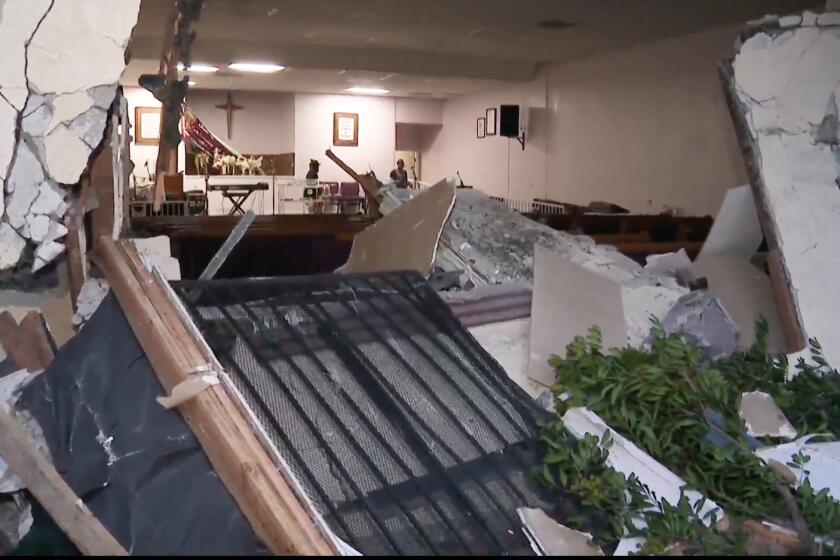In Jolt to O.C., Navy to Sell Off El Toro Land
Hours after Orange County voters rezoned a proposed international airport out of existence, Navy officials unexpectedly announced Wednesday that they intend to auction off the El Toro Marine base where it would have been built.
The move, which effectively kills any chance of a new Orange County regional airport on the 4,700-acre site, caught transportation officials by surprise and left a gaping hole in plans to use El Toro to alleviate anticipated air-traffic congestion across Southern California.
The decision probably will increase pressure on Los Angeles International Airport and other regional airfields from Long Beach to Ontario. While there is room for some expansion at those airports, experts said it is unlikely it could keep pace with the projected need. Political tensions could escalate over who should bear the noise and inconvenience of an airport designed to serve a broad public.
“I think it increases pressure on some other airport to get built into that second [major] regional airport,” said Raphael Sonenshein, a Cal State Fullerton political science professor. “At a certain point you have to start all over again and ask what the purpose is of the expansion, and put everything on the table, including whether LAX or Southern California should have that much air traffic.”
What will ultimately happen to the closed El Toro base is uncertain after the Navy’s decision. Although Orange County voters Tuesday overwhelmingly backed Measure W to rezone the area as parkland, that doesn’t mean a park will get built.
Under one scenario bandied about Wednesday, developers could embark on a land rush, buying up chunks of the former base, drafting development plans and then having Irvine annex the area, removing the development shackles imposed by Measure W.
The motivation is money. Analysts estimate that prime land at the site could be worth $750,000 to more than $1 million an acre. The site, near affluent communities in south Orange County, is the largest piece of developable property that private landowners do not already own in the county.
“The interest on a scale of one to 10 will be a 10 for anybody that’s a land buyer,” said Craig Atkins, a principal at O’Donnell/Atkins Co., a land brokerage in Costa Mesa.
Cox Had Supported Letting Market Decide
The Navy’s decision was a partial victory for Rep. Chris Cox (R-Newport Beach), who has advocated for eight years that the base should be sold and market forces should decide what would be built.
Cox said Wednesday that Defense Department officials only recently became receptive to the idea.
The key difference was the Sept. 11 terror attacks, he said. With war in Afghanistan, defense officials wanted to dispose of two bases in Orange County, one at El Toro and the other in Tustin, and collect money from land sales.
“They were anxious to get these bases wrapped up,” Cox said. “They didn’t want to stay bogged down in local planning decisions. I was encouraging them to move as soon as [the vote was in on] Measure W. . . . You can believe that the Pentagon would have taken the same steps to pursue aviation uses at El Toro if the vote had gone the other way.”
Regionally, scrapping plans for an El Toro airport could fuel an air transportation crunch and retard economic growth, experts said.
“Expanded regional airport capacity and diversity is important over the next 20 years,” said Stephen Levy, director of the Center for Continuing Study of the California Economy in Palo Alto. “It will definitely constrain the economy if there is no other capacity built outside of LAX.”
But anti-airport forces dispute assumptions that Southern California will face an air-capacity shortage without El Toro. They say Orange County’s population will increase by only about 500,000 in the next 20 years and that air-travel demands can be met by John Wayne Airport and other area airports.
Under current proposals, LAX could add up to 17 million passengers a year. Ontario International Airport’s passenger volume could be doubled to more than 15 million a year. And several million more passengers a year could be added to John Wayne.
But if trends continue, regional demand will increase from 90 million passengers a year to 164 million by 2025, according to estimates by the Southern California Assn. of Governments, a regional planning agency. The association also predicts that air cargo will almost triple from 3 million tons a year to 9 million tons by 2025 for Los Angeles, Orange, Ventura, Riverside and San Bernardino counties.
Failure to build El Toro could cost the region up to 135,000 jobs and $16 billion to $18 billion a year in lost commerce, the association has said.
“There will be a significant impact on employment growth in the region,” said SCAG Executive Director Mark Pisano. “The economic decline is not small and we will still have deficiencies despite improving other airports.”
While the region’s facilities can accommodate some of the projected demand in air travel, most of them have capacity limits and drawbacks for travelers.
The Palmdale Regional Airport, for example, is more than 100 miles from Orange County, presenting access problems. Ontario Airport has air pollution concerns that could frustrate expansion plans. John Wayne is capped at 8.4 million passengers a year through 2005; a recent proposal endorsed by Orange County supervisors would limit growth there to 9.8 million until 2015.
Los Angeles Mayor James K. Hahn has proposed that LAX’s planned expansion be limited to 78 million passengers a year. The volume is now about 61 million. But LAX expansion opponents said Wednesday that they oppose adding passengers to the facility’s aging infrastructure, already at 52% over the capacity it was built to serve in 1960.
“The mayor is committed to the 78 million annual passenger cap,” said Deputy Mayor Matt Middlebrook. “Los Angeles is taking responsibility for what it can take responsibility for. Orange County and northern San Diego County can’t look to Los Angeles to solve their problems forever. If not El Toro, they need to look for other solutions to their need for air transportation.”
Hahn announced last fall that he would scale back a $12-billion expansion plan for LAX developed under his predecessor, Richard Riordan. The mayor also has asked airport commissioners to “intensify planning to develop Palmdale Regional Airport” by marketing the facility to airlines and developing a master plan for the 17,000-acre airport, which has no commercial air service.
Both Sides Caught Off Guard by Decision
The Navy’s announcement that it would carve up El Toro caught both sides of Orange County’s airport debate off guard. Yet there were murmurings in recent months that Navy officials were tired of the seemingly endless bickering--which included four ballot issues over eight years--and would move to end the controversy.
Navy officials telegraphed their intentions last week when they threatened to sell another Orange County property, the 1,600-acre former Tustin helicopter base, if local authorities couldn’t agree on a redevelopment plan. The Navy ultimately agreed to turn over most of the base to Tustin but kept a 240-acre residential area to sell.
The Navy said it would sell El Toro--whether in pieces or as a whole--to the highest bidder, and in keeping with zoning changes included in Measure W, which passed Tuesday by a 58% to 42% vote. The proceeds would go to the Defense Department’s Base Closure Fund.
“We’ll work closely with the federal government and community to evaluate our options,” said Gary Simon, head of the county’s El Toro planning office.
The Navy’s decision won’t deter an expected legal challenge to Measure W by airport supporters, who argue that disposal of a federal military base is too important to be decided by a local zoning measure.
The sell-off will probably shift the nine-year, $100-million battle over what to do with El Toro from a debate over airports to such issues as homes versus businesses and schools versus factories.
The El Toro debate was long and rancorous, and the lines were sharply drawn on election day. About 44% of South Orange County voters went to the polls, compared with 33% of North County voters. About 81% of South County voters supported Measure W, while 63% of North County voters opposed it.
A federal environmental review of the base--required before the Navy can dispose of the land--will be released Friday, Navy officials said. Cox said the review has been written to “comfortably comply with Measure W, so that no aviation use will be further pursued by Washington.”
Airport critics said selling off El Toro won’t erase worries about toxic contamination at the air base, which is on the nation’s list of the most toxic public properties.
“I’m not sure who’s going to buy four runways and all of the toxics underneath those runways,” said Bruce Nestande, chairman of one of two groups that has promoted an El Toro airport since 1994. “It’s not going to be that simple.”
Conveyance of the property for another use is still possible, officials said, but the only application before the Navy is for an airport that voters have said the county can no longer build.
*
Times staff writers Jennifer Oldham, Ray Herndon, Daryl Strickland and Richard Simon contributed to this report.
More to Read
Start your day right
Sign up for Essential California for news, features and recommendations from the L.A. Times and beyond in your inbox six days a week.
You may occasionally receive promotional content from the Los Angeles Times.








